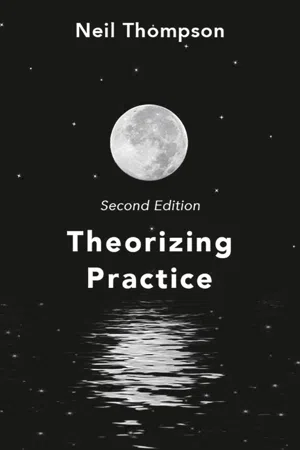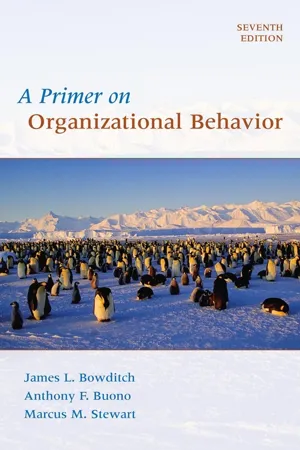Psychology
Group Dynamics
Group dynamics refers to the interactions, relationships, and processes within a group. It encompasses how individuals within a group influence one another, as well as the overall behavior and performance of the group. Understanding group dynamics is important for studying how groups form, function, and evolve, and it can provide insights into leadership, communication, and decision-making within groups.
Written by Perlego with AI-assistance
Related key terms
1 of 5
6 Key excerpts on "Group Dynamics"
- eBook - ePub
- Michele Kehoe(Author)
- 2013(Publication Date)
- Gill Books(Publisher)
9GROUPS AND TEAMSObjectives This chapter will help you to:- Propose a definition of a group.
- Identify the reasons for group formation.
- Describe the difference between a formal and informal group.
- Understand the stages of group development.
- Examine important factors influencing group performance.
- Appreciate the benefits of teamworking.
Group Dynamics is the study of people in groups and also a general term used for group processes. In psychology and sociology, a group is two or more individuals who are associated with each other through social relationships. As a result of the fact that people in groups interact with and influence one another, groups develop a number of dynamic processes that separate them from a random collection of individuals. These group processes include norms, roles, development, need fulfilment, social influence and effects on behaviour. The main focus of the field of Group Dynamics is primarily concerned with small group behaviour.A psychological group is any number of people who (a) interact with each other, (b) are psychologically aware of each other, and (c) perceive themselves to be a group (Schein, 1988).A group is two or more persons who interact with one another in such a manner that each person influences and is influenced by each other person (Shaw, 1991).The concept of interaction is central to the definition of a group. If people do not communicate with each other, they will not be able to share knowledge, beliefs or feelings and therefore will not influence each other. Those who interact with one another through face-to-face meetings, phone calls, e-mail and through many other channels of communication will exchange information and have an effect on each others’ thoughts, feelings and behaviour. Interaction will lead to the development of the group; the quality of the interaction will depend on the type of group. - eBook - PDF
- Lisa J. Cohen(Author)
- 2016(Publication Date)
- Visible Ink Press(Publisher)
What are Group Dynamics? Group Dynamics refer to the ways that people interact within groups and the ways that groups behave as a whole. Importantly, Group Dynamics exist apart from the personalities of individuals that make up the group. While the personalities of the people in the group influence the way that the group behaves, there are characteristics of the group that exist independently of any single group member. Why are Group Dynamics important? The study of Group Dynamics is important because groups are important. Our relationships with groups pervade almost every aspect of our lives. We are raised in families and educated in schools. Most of us work in a group setting and many of us live in families of our own. Moreover, we all live in a community, belong to one or more ethnic groups, and are categorized into a specific gender. Groups shape our daily life, powerfully influence our identity and self-esteem, and even shape our very perception of the world around us. Because of the importance groups play in our success as a species, much of our orientation to groups is deeply embedded in our psychology. Therefore to fully understand human psychology, it is important to understand Group Dynamics. What benefits do groups offer? Humans have a very strong drive to join groups and maintain group ties, and our experiences in groups elicit powerful emotions. Feeling part of a group can create a sense of comfort, connection, and belonging, all of which increase emotional wellbeing. When people lack a sense of belonging to a group, they can feel alienated, anxious, and lonely. This drive towards groups is very likely encoded in our genes. From this we can infer that groups confer a significant evolutionary advantage. What might that be? How might our orientation to groups have helped our species survive? For our earliest ancestors, groups provided protection from predators and the elements as well as the opportunity to share resources. - eBook - PDF
Group Dynamics and Organizational Culture
Effective Work Groups and Organizations
- Athena Xenikou, Adrian Furnham(Authors)
- 2017(Publication Date)
- Red Globe Press(Publisher)
These powerful forces may affect individual employees, as well as the larger organization, in 4 Group Dynamics AND ORGANIZATIONAL CULTURE either positive or negative ways. Group Dynamics refer to all the psychological processes that take place in groups. Kurt Lewin (1951), importing gestalt ideas to social psychology, put emphasis on describing the total situation; that is, the configuration of forces, not its isolated elements, when studying socio-psychological phenomena. Groups, therefore, are social entities that in some respects are greater than the sum of their parts. The social environment consti-tutes the psychological field in which various facilitating and inhibitory forces are activated, eventually determining human behaviour. Although Lewin’s ideas have been very influential in organizational psychol-ogy, the importance of group processes at work has been highlighted primarily by the human relations school of thought, which originated from the sem-inal Hawthorne studies. These studies were conducted for almost a decade from the beginning of the 1920s to the start of the 1930s, and they revealed that social factors at work had a more profound effect on productivity in comparison to physical conditions, such as the level of illumination or venti-lation. They changed the way people thought about work. The emerged human relations approach argued that work productivity depends on the formal and informal social environment that exists at work, and the extent to which the organization is prepared to meet employees’ needs for recognition, respect, acceptance and group membership. There are, however, a number of criticisms of the Hawthorne experiments; perhaps the most serious concerns the research methodology employed since there were only a few observations of some small samples of work groups. Moreover, the basic assumption of the human relations perspective about the cooperative or social nature of human beings has been fiercely challenged. - eBook - PDF
Theorizing Practice
A Guide for the People Professions
- Neil Thompson(Author)
- 2017(Publication Date)
- Red Globe Press(Publisher)
Family dynamics– that is, the interactions between family members that can be highly Group Dynamics AND INTERGROUP RELATIONS 109 significant – form a phenomenon that we need to take seriously. As we have noted in our discussions of atomism, it is a common mis-take to see individuals in isolation, without taking account of the influence of the wider social context. The role individuals play in their family and how their family plays a part in the development of their problems (and, as we shall see, their potential solutions) is a key part of that social context. Developing an understanding of group processes therefore has to incorporate a detailed understanding of family dynamics. Indeed, this is the basis of family therapy, a well-established practice modality (Carr, 2012 ). An important concept here is the notion of ‘family scripts’ (Byng-Hall, 1995 ). Families can be seen to develop their own narra-tives, their own stories of reality that shape understanding. If we try to engage with people without having some understanding of what their family script is telling them, then we are scratching at the sur-face and not really getting to grips with the complex factors that lie underneath. We are highly unlikely in such circumstances to have any considerable success. Finally, in terms of group processes, a further issue to put on the agenda is that of alienation. Reference was made earlier to the sig-nificance of people being estranged from their experiences. This can be a common occurrence when Group Dynamics, whether in families or other such groupings, have the effect of undermining confidence by making people feel that they do not belong or that they are not wor-thy. Practice focus 6.2 presents a good example of how Group Dynamics that produce and sustain negativity and cynicism will generally result in feelings of alienation. - eBook - PDF
Looking Back, Moving Forward
A Review of Group and Team-Based Research
- Elizabeth A. Mannix, Margaret Ann Neale, Elizabeth A. Mannix, Margaret Ann Neale(Authors)
- 2012(Publication Date)
- Emerald Group Publishing Limited(Publisher)
STUDYING DYNAMICS WITHIN GROUPS Laurie R. Weingart ABSTRACT Purpose – This chapter examines how we study Group Dynamics in the organizational behavior literature, in terms of the past, present, and future potential. The goal is to aid researchers in considering studying group processes in their own work. Methodology/approach – Examples are given of different approaches used to elucidate how Group Dynamics can be studied in terms of frequencies, phases, and sequences across a variety of group process domains. Findings – Results of the review suggest that while there has been more interest in studying Group Dynamics and examples can be found in the literature, there is still much opportunity for additional research. Advancements in theory and methods provide the means for doing so. Originality/value – Suggestions are provided for groups researchers on how to put their existing recordings of group processes to work. Keywords: Group processes; Group Dynamics; teams; research methods Looking Back, Moving Forward: A Review of Group and Team-Based Research Research on Managing Groups and Teams, Volume 15, 1–25 Copyright r 2012 by Emerald Group Publishing Limited All rights of reproduction in any form reserved ISSN: 1534-0856/doi: 10.1108/S1534-0856(2012)0000015004 1 Groups research has traditionally focused on inputs to the group (e.g., group composition and resources) and outputs from the group (e.g., decisions made, problems solved, quantity of output produced, etc.). While group process is acknowledged by groups researchers as a component of group performance, process has often been inferred rather than being an area of research focus in its own right. - eBook - PDF
- James L. Bowditch, Anthony F. Buono, Marcus M. Stewart(Authors)
- 2015(Publication Date)
- Wiley(Publisher)
C H A P T E R F I V E Group Dynamics E ver since the Hawthorne Studies and the Human Relations movement, re- searchers have increasingly focused their attention on the structure, dynamics, and impact of group behavior. This growing body of research has indicated the numerous ways in which groups can positively and negatively affect member satisfaction and per- formance, productivity, product and service quality, and a range of other organizational goals and outcomes. Indeed, the overall success of a complex organization is signifi- cantly influenced by the performance of a number of interacting groups throughout the firm’s hierarchy. Despite the centrality of groups in our lives and their importance and inevitability in organizations, we often take them for granted. We rarely take the time or effort to observe what is going on in a group, why different members behave in certain ways, why some groups appear more effective than others, how one group may affect another, and so forth. In order to have a fuller understanding of organizational behavior (OB), however, it is critical to develop an awareness of and ability to analyze the influence of groups on their individual members, interpersonal relations, and organizational activities. It is also important for managers to have insight into the problems as well as the potentialities associated with using and working with groups. 1 As a foundation for such an understanding, this chapter will focus on intragroup processes and dynamics. The discussion focuses on different types of groups, basic group attributes, the stages and behaviors often found in group development, and the ways in which we can observe and improve group process and interaction. Chap- ter 6 takes an applied look at a variety of work-related teams, including problem- solving teams, cross-functional teams, self-managed teams, learning teams, and vir- tual teams, and examines the interaction between different groups and teams in an organization.
Index pages curate the most relevant extracts from our library of academic textbooks. They’ve been created using an in-house natural language model (NLM), each adding context and meaning to key research topics.





